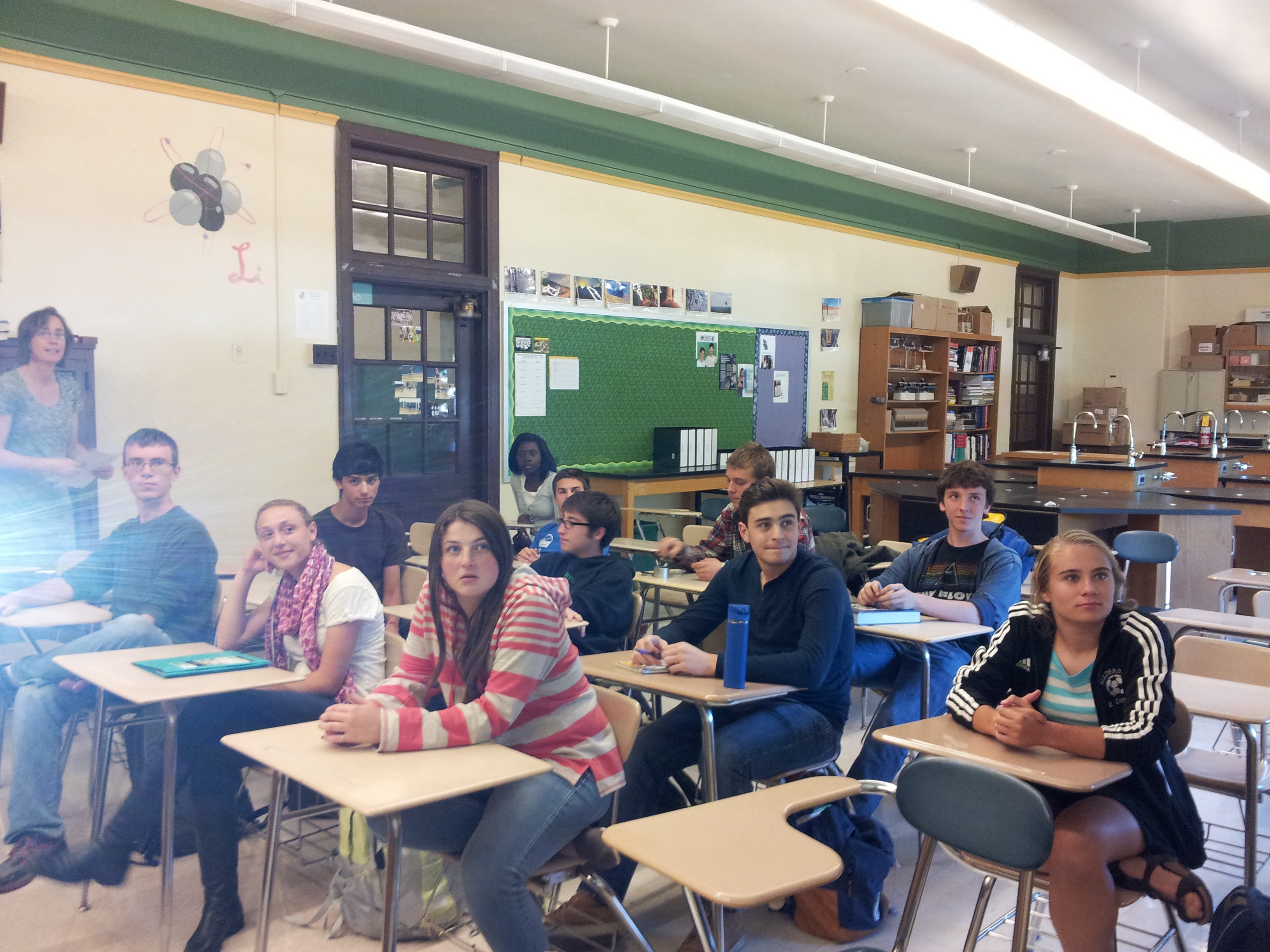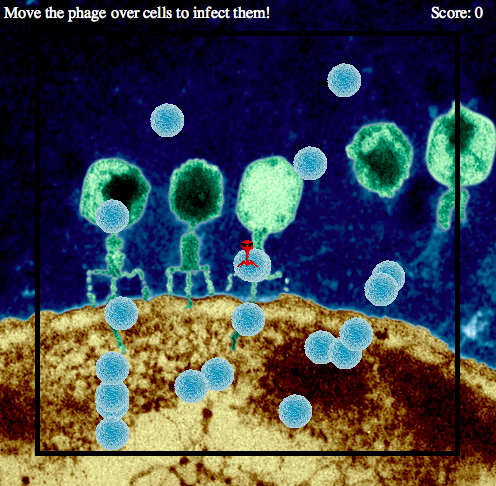Team:Carnegie Mellon/Presentations
From 2013.igem.org
| (12 intermediate revisions not shown) | |||
| Line 2: | Line 2: | ||
<html> <br><br> | <html> <br><br> | ||
| - | <h2>Overview of | + | <h2>Overview of human practices</h2> |
<p> | <p> | ||
Much of our human practices work focused on educating members of the public about: | Much of our human practices work focused on educating members of the public about: | ||
| Line 14: | Line 14: | ||
</p> | </p> | ||
<br> | <br> | ||
| - | <h2>Presentations to | + | <h2>Presentations to high school students and undergraduates</h2> |
<p><b>Friday, June 28th</b></p> | <p><b>Friday, June 28th</b></p> | ||
| Line 34: | Line 34: | ||
<br> | <br> | ||
<html> | <html> | ||
| - | <h2> Phage | + | <h2> Phage games </h2> |
| - | <p>We made two phage games in order to illustrate some aspects of the project in an interactive way | + | <p>We made two phage games in order to illustrate some aspects of the project in an interactive way:</p> |
| + | <p><b>The Laser Game:</b> This game focuses on the concept of killing with light. In it, the player must point a 585nm laser at KillerRed lysogens that are moving rapidly across the screen. If the laser is shined long enough on a cell it will lyse. We plan to make additional improvements including the ability to use points to buy upgrades. These upgrades will represent certain variables in our experiments including copy number, IPTG, brightness of light, etc.</p> | ||
| - | <p>The | + | <p><b>Phage Infection Blitz:</b> The player is presented with a bunch of cells moving across the environment. The player moves the red phage around, trying to attach it to cells. Once the phage attaches to a cell, it kills the cell! Here is what it looks like: </p> |
| - | </p> | + | </html> |
| + | [[image:Cell_game_photo.png|thumb|400px|center|]] | ||
| + | <html> | ||
<br> | <br> | ||
| - | <h2>Other | + | <h2>Other outreach activities</h2> |
<p><b>Friday, August 9th</b></p> | <p><b>Friday, August 9th</b></p> | ||
| Line 47: | Line 50: | ||
<p><b>October</b></p> | <p><b>October</b></p> | ||
| - | <p>With the completion of the phage games we have interest from the founder of the PhageHunters program, Dr. Graham Hatfull and Deborah Jacobs-Sera in using the games as part of the curriculum. The students will also meet with Dr. Javier Lopez who teaches the class at Carnegie Mellon and Dr. John Pollock who is at Duquesne University and very interested in using technology to teach science.</p> | + | <p>With the completion of the phage games we have interest from the founder of the <a href="http://phagesdb.org/phagehunters/">PhageHunters</a> program, Dr. Graham Hatfull and Deborah Jacobs-Sera in using the games as part of the curriculum. The students will also meet with Dr. Javier Lopez who teaches the class at Carnegie Mellon and Dr. John Pollock who is at Duquesne University and very interested in using technology to teach science.</p> |
| - | <p>We are spreading the word about iGEM! One of the high school students from the DiSCoBio program to which we gave a presentation in June used our project as her a motivation for her summer project. She and her teachers from a Pittsburgh area high school invited us to present at their school. They are also interested in forming a high school team.</p> | + | <p>We are spreading the word about iGEM! One of the high school students from the <a href="http://www.upci.upmc.edu/summeracademy/">DiSCoBio</a> program to which we gave a presentation in June used our project as her a motivation for her summer project. She and her teachers from a Pittsburgh area high school invited us to present at their school. They are also interested in forming a high school team.</p> |
| + | |||
| + | <h2>3D printing</h2> | ||
| + | <p>The 3D printed bacteriophage was created to be used as a tool for educators to use to facilitate learning. Visual aids and physical models are integral to the learning process and can help to illustrate otherwise complicated concepts. This phage was modeled using SolidWorks® 2013. If you are familiar with SolidWorks and are interested in editing the .SLDPRT file, it is available (below), as well as the .STL file, which is the file you would require to 3D print this design. Our 3D printed phage were created using a MakerBot Replicator 2. Aaaaw, isn't he cute?</p> | ||
| + | <center> | ||
| + | <a href="https://static.igem.org/mediawiki/2013/0/0f/Cmu3DPhage.zip">CLICK HERE TO DOWNLOAD THE .SLDPRT AND .STL FILES</a> | ||
| + | <br><br> | ||
| - | < | + | <img src="https://static.igem.org/mediawiki/2013/3/38/3dbacteriophage.jpg" width="133" height="191"></center> |
| - | + | ||
</html> | </html> | ||
Latest revision as of 01:21, 28 September 2013
Overview of human practices
Much of our human practices work focused on educating members of the public about:
- The overall goals and methods of synthetic biology
- How the iGEM competition works, and its contribution to synthetic biology
- The goals and findings of our project in particular
- The danger that antibiotic-resistant bacteria pose to all of us
Presentations to high school students and undergraduates
Friday, June 28th
A presentation about iGEM, Synthetic Biology, and Antibiotic Resistance was given at the University of Pittsburgh to 30 students in several summer programs: Systems Medicine REU (SysMed) program in the Chemical Engineering Department; Training and Experimentation in Computational Biology (TECBio) program for undergraduate students in the Department of Computational and Systems Biology; Drug Discovery, Systems and Computational Biology (DiSCoBio) program for high school students in the Department of Computational and Systems Biology, and part of the UPCI Summer Academy Program.
Friday, July 19th
High school students participating in the CMU Summer Academy for Mathematics + Science (SAMS) summer programs came to visit the lab to hear about the iGEM project as part of a lab “scavenger hunt”. The team gave short 5 minute presentations to 8 small groups of about two students each, explaining the biological advantages that bacteriophage and our system in particular have over antibiotics.
Friday, September 20th
The team talked informally with a prospective Carnegie Mellon undergraduate and his parents interested in iGEM.
Monday, September 23rd
A presentation about iGEM and Antibiotic was presented to juniors and seniors at Pittsburgh SciTech in the Life Sciences and Environmental Sciences concentrations. This Pittsburgh Public School teaches a science and technology magnet program and they have funding to support an iGEM High School team in 2014.
Tuesday, September 24th
The iGEM and Antibiotic talk was presented to a class of Research Science seniors at Pittsburgh Allderdice High School. Allderdice is a traditional high school and offers every AP Science course offered by College Board.
Phage games
We made two phage games in order to illustrate some aspects of the project in an interactive way:
The Laser Game: This game focuses on the concept of killing with light. In it, the player must point a 585nm laser at KillerRed lysogens that are moving rapidly across the screen. If the laser is shined long enough on a cell it will lyse. We plan to make additional improvements including the ability to use points to buy upgrades. These upgrades will represent certain variables in our experiments including copy number, IPTG, brightness of light, etc.
Phage Infection Blitz: The player is presented with a bunch of cells moving across the environment. The player moves the red phage around, trying to attach it to cells. Once the phage attaches to a cell, it kills the cell! Here is what it looks like:
Other outreach activities
Friday, August 9th
The team was interviewed for inclusion in a DIYsect, the DIY Biology and the Biology-Art intersection documentary. The students were commenting on how iGEM was different from other research experiences and what motivated them to join the team.
October
With the completion of the phage games we have interest from the founder of the PhageHunters program, Dr. Graham Hatfull and Deborah Jacobs-Sera in using the games as part of the curriculum. The students will also meet with Dr. Javier Lopez who teaches the class at Carnegie Mellon and Dr. John Pollock who is at Duquesne University and very interested in using technology to teach science.
We are spreading the word about iGEM! One of the high school students from the DiSCoBio program to which we gave a presentation in June used our project as her a motivation for her summer project. She and her teachers from a Pittsburgh area high school invited us to present at their school. They are also interested in forming a high school team.
3D printing
The 3D printed bacteriophage was created to be used as a tool for educators to use to facilitate learning. Visual aids and physical models are integral to the learning process and can help to illustrate otherwise complicated concepts. This phage was modeled using SolidWorks® 2013. If you are familiar with SolidWorks and are interested in editing the .SLDPRT file, it is available (below), as well as the .STL file, which is the file you would require to 3D print this design. Our 3D printed phage were created using a MakerBot Replicator 2. Aaaaw, isn't he cute?

 "
"



